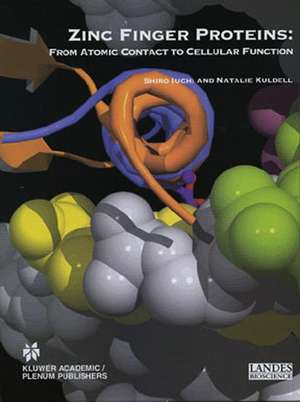Zinc Finger Proteins: From Atomic Contact to Cellular Function: Molecular Biology Intelligence Unit
Editat de Shiro Iuchi, Natalie Kuldellen Limba Engleză Hardback – 19 ian 2005
| Toate formatele și edițiile | Preț | Express |
|---|---|---|
| Paperback (1) | 947.80 lei 6-8 săpt. | |
| Springer Us – 23 dec 2010 | 947.80 lei 6-8 săpt. | |
| Hardback (1) | 817.72 lei 38-44 zile | |
| Springer Us – 19 ian 2005 | 817.72 lei 38-44 zile |
Din seria Molecular Biology Intelligence Unit
- 5%
 Preț: 663.61 lei
Preț: 663.61 lei - 18%
 Preț: 1229.10 lei
Preț: 1229.10 lei - 5%
 Preț: 1091.14 lei
Preț: 1091.14 lei - 24%
 Preț: 776.00 lei
Preț: 776.00 lei - 18%
 Preț: 1226.60 lei
Preț: 1226.60 lei - 15%
 Preț: 642.51 lei
Preț: 642.51 lei - 5%
 Preț: 1098.48 lei
Preț: 1098.48 lei - 15%
 Preț: 638.11 lei
Preț: 638.11 lei - 18%
 Preț: 944.99 lei
Preț: 944.99 lei - 5%
 Preț: 716.09 lei
Preț: 716.09 lei - 20%
 Preț: 552.99 lei
Preț: 552.99 lei - 5%
 Preț: 1096.62 lei
Preț: 1096.62 lei - 5%
 Preț: 1097.71 lei
Preț: 1097.71 lei - 18%
 Preț: 942.94 lei
Preț: 942.94 lei - 18%
 Preț: 1222.49 lei
Preț: 1222.49 lei - 5%
 Preț: 1408.97 lei
Preț: 1408.97 lei - 18%
 Preț: 947.04 lei
Preț: 947.04 lei - 5%
 Preț: 1094.60 lei
Preț: 1094.60 lei - 18%
 Preț: 945.79 lei
Preț: 945.79 lei - 24%
 Preț: 1053.41 lei
Preț: 1053.41 lei - 24%
 Preț: 786.20 lei
Preț: 786.20 lei - 24%
 Preț: 789.90 lei
Preț: 789.90 lei - 18%
 Preț: 945.62 lei
Preț: 945.62 lei - 5%
 Preț: 1095.90 lei
Preț: 1095.90 lei - 5%
 Preț: 1429.27 lei
Preț: 1429.27 lei - 5%
 Preț: 1104.84 lei
Preț: 1104.84 lei - 18%
 Preț: 947.85 lei
Preț: 947.85 lei - 15%
 Preț: 640.88 lei
Preț: 640.88 lei - 18%
 Preț: 951.29 lei
Preț: 951.29 lei - 5%
 Preț: 1095.73 lei
Preț: 1095.73 lei - 18%
 Preț: 950.33 lei
Preț: 950.33 lei - 18%
 Preț: 946.55 lei
Preț: 946.55 lei - 18%
 Preț: 952.89 lei
Preț: 952.89 lei - 5%
 Preț: 714.63 lei
Preț: 714.63 lei - 18%
 Preț: 946.41 lei
Preț: 946.41 lei - 18%
 Preț: 947.85 lei
Preț: 947.85 lei - 18%
 Preț: 956.03 lei
Preț: 956.03 lei - 5%
 Preț: 1293.05 lei
Preț: 1293.05 lei - 5%
 Preț: 1098.63 lei
Preț: 1098.63 lei - 18%
 Preț: 944.19 lei
Preț: 944.19 lei - 18%
 Preț: 950.52 lei
Preț: 950.52 lei - 24%
 Preț: 782.72 lei
Preț: 782.72 lei - 18%
 Preț: 953.65 lei
Preț: 953.65 lei - 15%
 Preț: 640.06 lei
Preț: 640.06 lei - 5%
 Preț: 1610.67 lei
Preț: 1610.67 lei - 18%
 Preț: 947.35 lei
Preț: 947.35 lei - 18%
 Preț: 1231.32 lei
Preț: 1231.32 lei - 15%
 Preț: 649.06 lei
Preț: 649.06 lei - 18%
 Preț: 1231.16 lei
Preț: 1231.16 lei
Preț: 817.72 lei
Preț vechi: 1075.95 lei
-24% Nou
Puncte Express: 1227
Preț estimativ în valută:
156.49€ • 162.78$ • 129.19£
156.49€ • 162.78$ • 129.19£
Carte tipărită la comandă
Livrare economică 10-16 aprilie
Preluare comenzi: 021 569.72.76
Specificații
ISBN-13: 9780306482298
ISBN-10: 0306482290
Pagini: 276
Ilustrații: XVI, 276 p.
Dimensiuni: 216 x 279 x 20 mm
Greutate: 0.98 kg
Ediția:2005
Editura: Springer Us
Colecția Springer
Seria Molecular Biology Intelligence Unit
Locul publicării:New York, NY, United States
ISBN-10: 0306482290
Pagini: 276
Ilustrații: XVI, 276 p.
Dimensiuni: 216 x 279 x 20 mm
Greutate: 0.98 kg
Ediția:2005
Editura: Springer Us
Colecția Springer
Seria Molecular Biology Intelligence Unit
Locul publicării:New York, NY, United States
Public țintă
ResearchCuprins
The Discovery of Zinc Fingers and Their Practical Applications in Gene Regulation: A Personal Account.- The Discovery of Zinc Fingers and Their Practical Applications in Gene Regulation: A Personal Account.- Binding of Zinc Fingers to DNA.- C2H2 Zinc Fingers As DNA Binding Domains.- TFIIIA: A Sophisticated Zinc Finger Protein.- GAGA: Structural Basis for Single Cys2His2 Zinc Finger-DNA Interaction.- The DNA-Binding Domain of GATA Transcription Factors—A Prototypical Type IV Cys2-Cys2 Zinc Finger.- MutM: Single C2C2 Zinc Finger-DNA Interaction.- Homing Endonuclease I-TevI: An Atypical Zinc Finger with a Novel Function.- Zinc Finger Interactions with Metals and Other Small Molecules.- Synthetic Zinc Finger Transcription Factors.- Binding of Zinc Fingers to RNA.- TFIIIA and p43: Binding to 5S Ribosomal RNA.- RNA Binding by Single Zinc Fingers.- Wig-1, a p53-Induced Zinc Finger Protein that Binds Double Stranded RNA.- Tandem CCCH Zinc Finger Proteins in mRNA Binding.- Ribosomal Zinc Finger Proteins: The Structure and the Function of Yeast YL37a.- Binding of Zinc Fingers to Proteins.- LIM Domain and Its Binding to Target Proteins.- RING Finger-B Box-Coiled Coil (RBCC) Proteins As Ubiquitin Ligase in the Control of Protein Degradation and Gene Regulation.- Structure and Function of the CBP/p300 TAZ Domains.- A Zinc Ribbon Motif Is Essential for the Formation of Functional Tetrameric Protein Kinase CK2.- Binding of Zinc Fingers to Small Molecules.- The FYVE Finger: A Phosphoinositide Binding Domain.- Common Domains Present in Zinc Finger Proteins.- The BTB Domain Zinc Finger Proteins.- KRAB Zinc Finger Proteins: A Family of Repressors Mediating Heterochromatin-Associated Gene Silencing.- The Superfamily of SCAN Domain Containing Zinc Finger Transcription Factors.- Biology ofZinc Finger Proteins.- Sp1 and Huntington’s Disease.- The Role of WT1 in Development and Disease.- Yin Yang 1.- The Multiple Cellular Functions of TFIIIA.- The Role of the Ikaros Gene Family in Lymphocyte Development.- Basonuclin: A Zinc Finger Protein of Epithelial Cells and Reproductive Germ Cells.- ZAS Zinc Finger Proteins: The Other ?B-Binding Protein Family.- Role of GATA Factors in Development.- The Androgen Receptor and Spinal and Bulbar Muscular Atrophy.- The Role of XPA in DNA Repair.- MOF, an Acetyl Transferase Involved in Dosage Compensation in Drosophila, Uses a CCHC Finger for Substrate Recognition.- MDM2: RING Finger Protein and Regulator of p53.- Biology of Zinc Ion.- The Zip Family of Zinc Transporters.- Apoptosis by Zinc Deficiency.
Caracteristici
The authors include a Nobel Prize laureate, several founders of zinc finger research and the related research fields, and well-known, cutting edge scientists Includes supplementary material: sn.pub/extras













